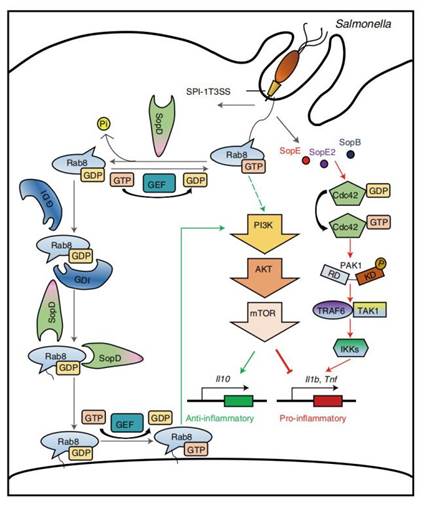On February 19, 2021, Dr. Gao Xiang's laboratory and Professor Jorge Galán's laboratory at Yale University School of Medicine published a research paper entitled "The Salmonella effector protein SopD targets Rab8 to positively and negatively modulate the inflammatory response" in Nature Microbiology. Professor Gao Xiang and Professor Jorge Galán are co-corresponding authors. Dr. Lian Huan in Galán's lab, Dr. Jiang Kun and a Ph.D. student in the Gao lab, Tong Ming are the co-first authors.
As a common food-borne pathogen,Salmonella usually infects the host through contaminated food or water. After infection, people usually show symptoms such as typhoid fever or gastroenteritis. To survive, multiply and disseminate in the host,Salmonella will secrete effector proteins to the host cell through its type III secretion system. The SopD family is a very conserved effector protein unique toSalmonella. Studies have shown that this family plays an essential role in the invasion, colonization and later system infection of Salmonella. However, its specific molecular mechanism is unknown.
In this study, the authors screened the potential targets of SopD based on the GTPase assay. The results showed that SopD is a GAP (GTPase activating protein) that specifically interacts with Rab8. By analyzing the complex crystal structure of SopD and Rab8, the authors found that their interaction interface is quite different from the classical GAP-Rab model, and this interface has a conflict with GDI-Rab interface in space, so it is speculated that SopD has another function similar to GDF (GDI replacement factor) in addition to its GAP activity. This hypothesis has been verified by the competitive CO-IP experiment in vitro and the cell infection experiment in vivo.

Schematic diagram of how SopD regulate Rab8
In summary, this study reveals the molecular mechanism of Salmonella effector protein SopD, and unexpectedly discovered that SopD is a rare effector protein with both "yin-yang" bidirectional functions. On the one hand, SopD inhibits the anti-inflammatory pathway mediated by Rab8 through its GAP activity, enhancing the inflammatory response, promoting the invasion and proliferation of Salmonella. On the other hand, SopD can release Rab8 from GDI through its GDF-like function, and promote the reactivation of Rab8; by enhancing the anti-inflammatory response mediated by Rab8, it helps host cells to restore homeostasis, which is beneficial to the long-term colonization of Salmonella in host cells. These findings not only facilitate the understanding of Salmonella's pathogenesis, but also show an outstanding product of the Salmonellaeffector protein in the evolution process,laying a theoretical foundation for the subsequent research on SopD protein and the development of antibacterial drugs targeting SopD.
This work was supported by the National Key R&D Program of China, the National Natural Science Foundation of China, the Major Basic Program of Natural Science Foundation of Shandong Province, the Youth Interdisciplinary Innovative Research Group of Shandong University, and the Taishan Young Scholars Program. The Shandong University Core facilities for life and environmental sciences and Shanghai Synchrotron Radiation Facility (SSRF) also provided important assistance for this work.
Link to the paper:https://dx.doi.org/10.1038/s41564-021-00866-3
Written by: Tong Ming